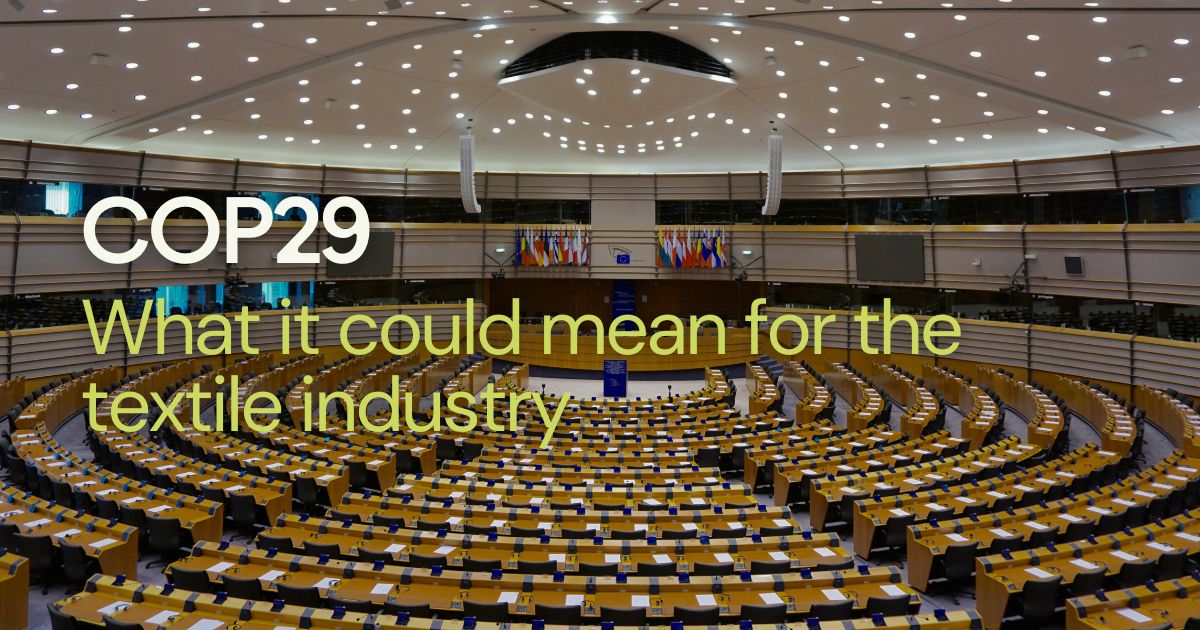 As global temperatures continue to rise, the implications of climate change for industries worldwide have never been more significant. Now in its final week, the 29th United Nations Climate Change Conference (COP29) is underway in Baku (Azerbaijan), bringing together representatives from nearly 200 countries to address climate-related challenges. For those of us working in the textile dyeing and finishing sector, understanding the possible implications of COP29 is crucial, as climate policies increasingly shape industry practices and supply chains.
As global temperatures continue to rise, the implications of climate change for industries worldwide have never been more significant. Now in its final week, the 29th United Nations Climate Change Conference (COP29) is underway in Baku (Azerbaijan), bringing together representatives from nearly 200 countries to address climate-related challenges. For those of us working in the textile dyeing and finishing sector, understanding the possible implications of COP29 is crucial, as climate policies increasingly shape industry practices and supply chains.
Key Takeaways:
- Stay informed: Monitor developments from COP29 and subsequent climate negotiations.
- Invest in sustainability: Embrace renewable energy and green technologies to future-proof your business operations.
- Build resilience: Strengthen supply chains and prepare for regulatory changes.
- Collaborate globally: Advocate for fair policies that support sustainable practices across all regions.
By aligning business strategies with global climate goals, the textile industry can not only adapt to a changing landscape, but also lead the charge towards a sustainable future.
COP29: A Brief Overview
What is COP29?
COP29, the 29th "Conference of the Parties," is the world's leading meeting on climate change. Organised under the UN Framework Convention on Climate Change (UNFCCC), this year it runs from November 11-22, in Baku (Azerbaijan). Delegates aim to advance global efforts to combat climate change, focusing on mitigation, adaptation, and finance.
Why Azerbaijan?
The choice of Baku has drawn criticism due to Azerbaijan's substantial investments in oil and gas, which contradict the conference's goal of reducing reliance on fossil fuels. This tension underscores the global challenge of balancing economic interests with climate action.
Key themes at COP29
- Financing climate action
- A major focus of COP29 is financing climate initiatives in developing nations. Under the 2015 Paris Agreement, wealthy countries pledged support to help poorer nations reduce emissions and adapt to climate impacts. However, progress on these commitments has been slow.
- The Target: Developing nations seek over $1 trillion annually by 2030.
- Challenges: Wealthier countries argue that emerging economies like China and Gulf States must also contribute to the funding.
- Energy transition and fossil fuels
- While COP29 seeks to accelerate the transition away from fossil fuels, Azerbaijan’s leadership and global political distractions have complicated progress. Concerns persist about some countries backtracking on prior commitments to phase out coal, oil, and gas.
- Accountability and National plans
- Countries are expected to update their climate strategies by February 2025, aligning with the Paris Agreement's goal of limiting global warming to 1.5°C. Weak or insufficient plans could erode trust between developed and developing nations.
Implications for the textile industry
For textile brands and manufacturers in developing countries, increased climate financing could provide access to green technologies and cleaner production methods. However, brands and manufacturers in developed nations may face increased costs if their governments redirect resources to meet international obligations.
Energy-intensive processes in textile dyeing and finishing could see higher costs as nations impose stricter carbon pricing and incentivise renewable energy use. Forward-thinking brand and textile manufacturers can benefit by adopting sustainable practices early, gaining a competitive edge as policies tighten.
Stricter national climate policies may lead to regulatory pressures on textile supply chains, particularly in regions with high emissions. Transparency in emissions reporting will likely become a key compliance factor for brands, manufacturers, and suppliers.
Opportunities for the textile industry
Despite the challenges, COP29 presents significant opportunities for the textile industry to innovate and keep the lead in sustainability:
- Transition to renewable energy
- Incentives for renewable energy adoption could reduce reliance on fossil fuels for energy-intensive dyeing processes.
- Solar and wind energy solutions can lower operational costs in the long term.
- Adoption of cleaner technologies
- Financial mechanisms agreed upon at COP29 may subsidise the development and deployment of eco-friendly technologies.
- Innovations like waterless dyeing or bio-based dyes can position brands and manufacturers as industry leaders.
- Supply chain resilience
- Strengthening supply chain transparency and investing in carbon footprint tracking can align brands and manufacturers with emerging regulatory standards.
- Collaboration with suppliers to reduce emissions will become a competitive differentiator.
Preparing for a sustainable future
COP29 underscores the urgency of global action on climate change, with significant implications for industries worldwide. For the textile dyeing and finishing sector, the conference serves as both a challenge and an opportunity. Stricter regulations, shifting energy policies, and evolving consumer expectations demand proactive adaptation.
Alchemie Technology supports climate initiatives
As COP29 wraps up this week, we hope it drives meaningful steps toward addressing climate change. The textile industry is a major contributor to global pollution, responsible for over 3% of CO2 emissions and ranking as the second largest source of industrial wastewater pollution. At Alchemie, we are committed to eliminating the environmental impact of these harmful processes.
If you want to learn more, visit Our Technology.